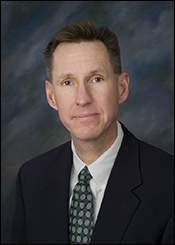From ‘Happy Accidents’ to
Intentional Beef Quality
Higher-producing cattle require a more specialized approach to feeding.
Doing more with less. In the cattle business, that’s more than a nice idea; it’s the new survival plan.

“Value for ‘known’ feeder cattle will shift from simply reputation and feeding experience to include measurable diagnostics that improve predictability,” said Pete Anderson, director of research for Midwest PMS.
“In any manufacturing system, if the number of units is reduced, the revenue per unit must increase,” said Pete Anderson, director of research for Midwest PMS, a U.S. livestock feed company. “The cattle industry must focus on maximizing revenue from each animal produced.”
Larger carcasses? Certainly, he said, but also increasing the value of each pound sold.
Anderson presented his paper, “External influences on North American beef production: How will the cattle feeding industry adapt?” as part of the Plains Nutrition Conference in San Antonio, Texas, in April. The full paper is available at www.cabpartners.com/news/
research.php.
“Premium carcasses like Certified Angus Beef® (CAB®) brand or Prime used to be a happy accident that occurred at the outer end of the population distribution, just because there were millions of cattle fed,” he said.
Becoming intentional
Packers creamed the coolers to find quality they could sell for a higher value, but today real-world examples show ranchers reaching 50% CAB brand and Prime on large numbers of cattle, with better-than-average feedlot performance.
“Economic signals are telling us that we need to do more of that,” Anderson said. Even with a spike in grading, the Choice-Select spread remains relatively strong and premiums for CAB are increasing.
“While U.S. per-capita consumption has declined with supply, increasing prices are a sign of solid demand; a growing population will continue to consume beef,” he said, but the opportunities aren’t limited to domestic growth.
Exports accounted for $307 per head in 2013, according to the U.S. Meat Export Federation (USMEF). By 2030, North America and Europe will have just 18% of the world’s middle-class population, compared to 63% in the Asian Pacific.
“North America should get in, stay in and dominate the premium beef market,” Anderson said. “Our resources are best utilized creating big, high-quality cattle that produce an enjoyable eating experience and maximize revenue per animal.”
The cattle that fit that description will only get more valuable, he predicted.
“We will not manage $2,000 cattle the same way that we used to manage $900 cattle,” Anderson noted. “While in the past, cost of production was the primary focus, emphasis will shift toward growing revenue.”
That requires a more specialized approach than the feeding industry typically uses today, he said, one based on individual records, sorting and performance projections with applied management and marketing.
“Value for ‘known’ feeder cattle will shift from simply reputation and feeding experience to include measurable diagnostics that improve predictability,” Anderson said.
The economics of tools such as DNA testing change when comparing 30 million head of feeder cattle worth $700 each to 24 million worth $1,300 apiece.
Creating a premium product generates more revenue, but it does nothing to produce more product.
“Despite a shrinking cattle herd, beef production in tons has increased since 1950,” he said. Cattle numbers have dropped, “but productivity increased dramatically so that we now get more beef and more milk from 90 million cattle than we used to get from nearly 140 million.”
Growth genetics are a large part of that success story, and Anderson expects that to continue.
In the Midwest PMS database for the last quarter of 2013, nearly 25% of the steers gained more than 4 pounds (lb.) per day and converted at less than 6 lb. of feed per 1 lb. of gain. The average “out” weight was 1,469 lb.
“The proliferation of big, high-performing cattle changes the economics of cattle feeding and creates new opportunities,” Anderson said. In addition to improved potential, the use of technology and a marketing shift (from a live-weight to a carcass-weight basis) accelerated this trend across the industry.
How big is too big?
“It is hard to bet against a straight line for 40 years, but there are reasons to expect the increase to pause for a while,” Anderson said. Those include beta-agonist and implant usage leveling off, along with drought implications.
Experts predict heifer retention will soon increase cow numbers, but Anderson said this “maximize-each-head philosophy” will still apply.
“The recent USDA projection of a 16% increase in the U.S. cow herd by 2023 seems more like the upper limit of possibility than a realistic forecast,” he said.
Challenging times give the beef industry an opportunity to write its own story.
“Cattle producers are subject to external influences to a greater degree than ever before,” Anderson said. “Responses to these forces will shape the industry and determine its future.”

Editor’s Note: Miranda Reiman is assistant director of industry information for Certified Angus Beef LLC’s Supply Development team.





